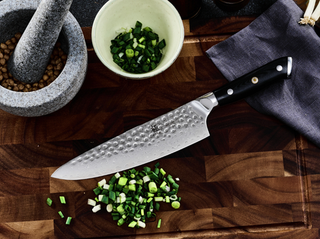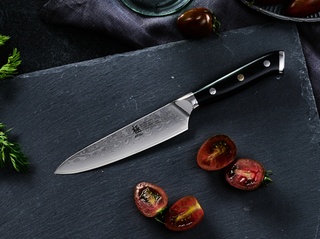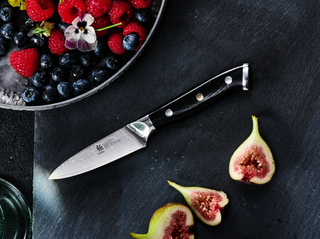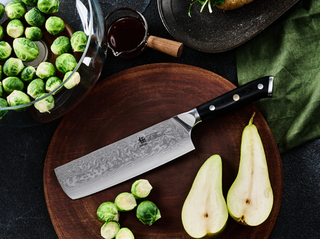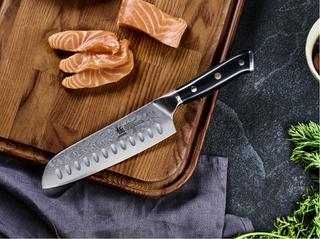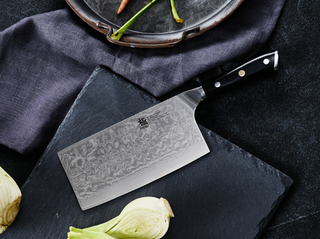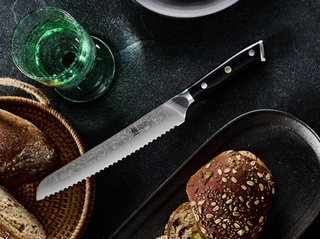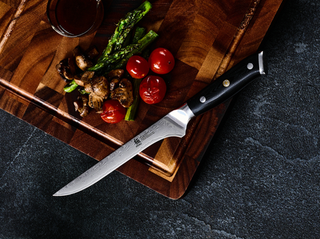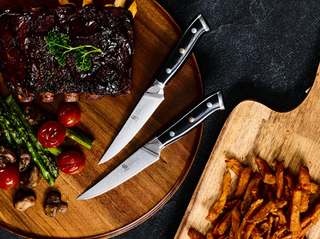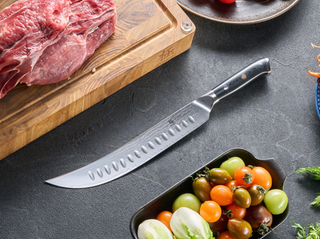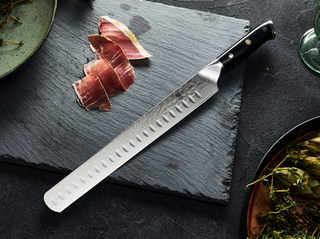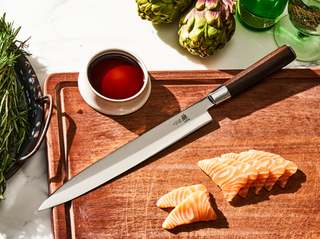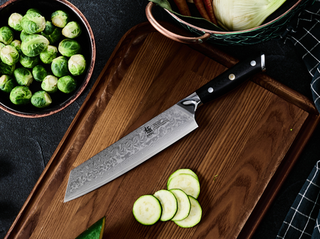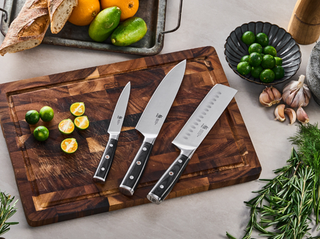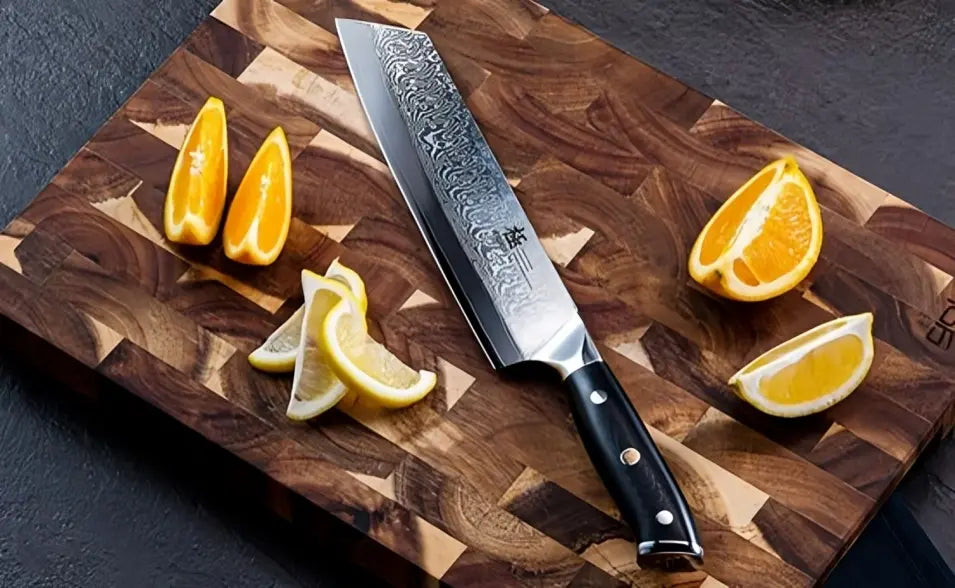Think about the last time you prepared dinner, did you find yourself switching between multiple knives, or wishing you had better control when breaking down vegetables? The chef knife size affects everything from how quickly you can prep ingredients to how your wrist feels after cooking.
Let's explore why knife length matters more than most home cooks realize, and how choosing the right chef knife size can fundamentally change your cooking experience.

What is a Chef Knife Used For
Have you ever noticed how professional chefs seem to use just one knife for almost everything? That's their chef knife in action.
While home cooks often reach for different knives - a small one for garlic, another for meat, maybe a third for vegetables - a good chef knife handles it all.
The magic lies in its curved blade and tapered tip: rock it forward to mince herbs into tiny flakes, use the middle for smooth slicing through tomatoes, or leverage the heel to split a butternut squash. Master this one knife, and you'll cut your prep time in half while actually improving your cuts.
How to Choose the Best Size Chef Knife

The "best" size depends on several personal factors that are worth considering:
Hand Size and Strength:
If you have smaller hands or prefer more precise control, you might feel more comfortable with a 6-inch (150mm) chef's knife. Conversely, those with larger hands or more experience might prefer a 10-inch (250mm) blade for increased cutting power and efficiency.
Counter Space:
Consider your typical workspace. An 8-inch knife requires about 10 inches of clearance for comfortable use. If you have limited counter space, a 6-inch knife might be more practical.
Cooking Style:
Think about what you cook most often. If you frequently break down large cuts of meat or work with bigger vegetables, a longer 10-inch blade could serve you better. For more delicate tasks or smaller ingredients, a 6-inch chef knife offers better precision.
Experience Level:
For beginners, I'd recommend starting with an 8-inch chef knife. It's manageable enough to learn proper technique while being versatile enough to handle most kitchen tasks. As you develop your skills, you might want to experiment with different sizes.

Chef Knife Size:
The most versatile and commonly recommended chef knife size is 8 inches (200mm). An 8-inch chef knife’s blade typically weighs between 6-8 ounces, which most people find comfortable for extended use. Longer blades are heavier and can cause fatigue more quickly if you're not used to them.
While 8-inch chef knives dominate the market, there's no universal "best" size. Think about making a big batch of soup - with an 8-inch knife, you'll get through those onions, carrots, and celery efficiently, but someone with smaller hands might fight the knife more than the vegetables.
A 6-inch knife isn't "too small" - it's perfect for anyone who wants more control or has limited counter space.
And those impressive 10-inch blades? They'll glide through watermelon and cabbage like butter, but they demand respect and practice.

One helpful way to test if a knife size works for you is to mimic a chopping motion on a cutting board. The tip of the knife should just clear the board when the handle is level with your second knuckle while gripping the knife. This ensures proper control and efficient cutting motion.
Chef Knife Length:
The chef knife length also directly impacts its performance in different tasks.

A 6-inch chef knife (150mm) offers precise control for detailed cutting and works well in smaller spaces. The 8-inch chef knife (200mm) provides enough blade for most cutting techniques while remaining manageable for most users. A 10-inch chef knife (250mm) excels at processing larger ingredients and can be more efficient for experienced cooks, though it requires more skill to control.
When choosing length, consider that longer blades require more clearance on your cutting board and more strength to control, but they can slice through more food in a single stroke.
A 6-inch blade lets you pivot quickly between garlic cloves and gives you the precision to remove chicken tenders without waste. Move up to 8 inches, and you gain the ability to slice through an entire onion in one smooth motion - crucial for even cooking and no tears. At 10 inches, you're looking at professional efficiency: imagine breaking down a whole chicken in minutes instead of wrestling with each joint.
Again, it's about how the knife moves in your hand and across your cutting board.
Common Questions About Chef Knife Size
"Is my knife too big for my hands?"
Here's a simple test: hold your knife with a proper pinch grip (thumb and forefinger pinching the blade near the handle). Your knife should feel like an extension of your arm, not a weight you're managing. If you're constantly adjusting your grip or your wrist tires quickly, the knife is likely too large. A 6-inch chef's knife isn't "lesser" - it's often perfect for those with smaller hands or anyone who wants more precise control.
"Why do professional chefs use such big knives?"
There's a misconception that professional chefs always use longer blades. In reality, they choose their knife length based on volume and efficiency. When you're processing 50 pounds of vegetables daily, a longer blade means fewer cuts and less fatigue. But watch closely in professional kitchens - many chefs switch to shorter blades for detailed work. It's about using the right tool for the task, not showing off with the biggest knife.
"How does knife length affect cutting technique?"
This is where chef knife length really matters. With a shorter 6-inch knife, you'll find yourself using more up-and-down chopping motions. An 8-inch blade naturally encourages a rocking motion - the curved edge rolls smoothly across the cutting board. A 10-inch knife requires more forward motion in your cuts, almost like slicing through a loaf of bread. Understanding these differences helps you choose a length that matches your preferred cutting style.
Conclusion

The perfect chef knife size comes down to one key principle: it should feel like a natural extension of your hand, not a tool you're fighting to control.
While the classic 8-inch blade offers versatility for most home cooks, don't feel pressured by what others use. A 6-inch knife can give you precise control for detailed work, while a 10-inch blade excels at efficiency for larger ingredients. The best length is the one that matches your cooking style, hand size, and kitchen space.
Think about what you cook most often - if you're regularly breaking down whole chickens or chopping large vegetables, a longer blade might serve you better. But if you value maneuverability and precise cuts, a shorter blade could be your perfect match.
Kyoku's chef knife collection stands out by combining optimal sizing with exceptional Japanese steel craftsmanship. If you're ready to experience how the right size knife can transform your cooking, explore Kyoku's collection to find your perfect match.
